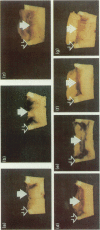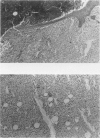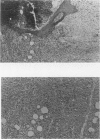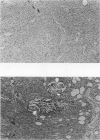Abstract
An established wound model in the pig has been modified using a Stomahesive ring to enable study of the effects of fluids used in wound care. Full thickness wounds (up to 9 mm deep) were treated with the substances under test. Each application was held in place with a Stomahesive flange, the inner part of which had been excised as far as the hard plastic ring. All dressings were then covered with OpSite which allowed gaseous exchange whilst retaining treatment fluids and secretions. Wounds were treated immediately and at 2 and 4 days. The experiment was terminated after 7 days and the whole wound, with dressing, was excised for histological examination. The wounds covered with OpSite alone and those treated with sugar paste under Opsite were found to be infilled with granulation tissue over which epidermal migration was taking place. Those wounds which had been packed with gauze, to which had been added one of the following: chlorhexidine gluconate 0.2%, Irgasan 0.2%, povidone iodine 0.8% or EUSOL half-strength, showed delayed healing in that less infilling had taken place over the same time period. This delay could be attributed to the nature of the chemicals used and/or the influence of gauze packing. This delay in the healing of wounds treated with chemical agents was least with EUSOL half-strength and greatest with chlorhexidine. No toxic effects were observed with sugar paste which may be preferable to antiseptics for the management of dirty or infected wounds.
Full text
PDF















Images in this article
Selected References
These references are in PubMed. This may not be the complete list of references from this article.
- Alper J. C. Recent advances in moist wound healing. South Med J. 1986 Nov;79(11):1398–1404. doi: 10.1097/00007611-198611000-00020. [DOI] [PubMed] [Google Scholar]
- Alvarez O. M., Mertz P. M., Eaglstein W. H. The effect of occlusive dressings on collagen synthesis and re-epithelialization in superficial wounds. J Surg Res. 1983 Aug;35(2):142–148. doi: 10.1016/0022-4804(83)90136-1. [DOI] [PubMed] [Google Scholar]
- Barnett S. E., Varley S. J. The effects of calcium alginate on wound healing. Ann R Coll Surg Engl. 1987 Jul;69(4):153–155. [PMC free article] [PubMed] [Google Scholar]
- Brennan S. S., Foster M. E., Leaper D. J. Antiseptic toxicity in wounds healing by secondary intention. J Hosp Infect. 1986 Nov;8(3):263–267. doi: 10.1016/0195-6701(86)90122-2. [DOI] [PubMed] [Google Scholar]
- Brennan S. S., Leaper D. J. The effect of antiseptics on the healing wound: a study using the rabbit ear chamber. Br J Surg. 1985 Oct;72(10):780–782. doi: 10.1002/bjs.1800721004. [DOI] [PubMed] [Google Scholar]
- Hamill M. B., Osato M. S., Wilhelmus K. R. Experimental evaluation of chlorhexidine gluconate for ocular antisepsis. Antimicrob Agents Chemother. 1984 Dec;26(6):793–796. doi: 10.1128/aac.26.6.793. [DOI] [PMC free article] [PubMed] [Google Scholar]
- Kaufman T., Eichenlaub E. H., Angel M. F., Levin M., Futrell J. W. Topical acidification promotes healing of experimental deep partial thickness skin burns: a randomized double-blind preliminary study. Burns Incl Therm Inj. 1985 Dec;12(2):84–90. doi: 10.1016/0305-4179(85)90032-4. [DOI] [PubMed] [Google Scholar]
- Kickhöfen B., Wokalek H., Scheel D., Ruh H. Chemical and physical properties of a hydrogel wound dressing. Biomaterials. 1986 Jan;7(1):67–72. doi: 10.1016/0142-9612(86)90092-x. [DOI] [PubMed] [Google Scholar]
- Laufer M., Ashkenazi C., Katz D., Wolman M. Orientation of collagen in wound healing. Br J Exp Pathol. 1974 Jun;55(3):233–236. [PMC free article] [PubMed] [Google Scholar]
- Leveen H. H., Falk G., Borek B., Diaz C., Lynfield Y., Wynkoop B. J., Mabunda G. A., Rubricius J. L., Christoudias G. C. Chemical acidification of wounds. An adjuvant to healing and the unfavorable action of alkalinity and ammonia. Ann Surg. 1973 Dec;178(6):745–753. doi: 10.1097/00000658-197312000-00011. [DOI] [PMC free article] [PubMed] [Google Scholar]
- Niedner R., Schöpf E. Inhibition of wound healing by antiseptics. Br J Dermatol. 1986 Aug;115 (Suppl 31):41–44. doi: 10.1111/j.1365-2133.1986.tb02106.x. [DOI] [PubMed] [Google Scholar]
- WINTER G. D. Formation of the scab and the rate of epithelization of superficial wounds in the skin of the young domestic pig. Nature. 1962 Jan 20;193:293–294. doi: 10.1038/193293a0. [DOI] [PubMed] [Google Scholar]
- WINTER G. D., SCALES J. T. Effect of air drying and dressings on the surface of a wound. Nature. 1963 Jan 5;197:91–92. doi: 10.1038/197091b0. [DOI] [PubMed] [Google Scholar]









